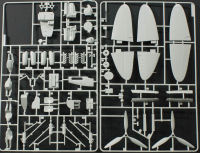
Revell 1/32 Mosquito B.IV Kit First Look
By Michael Benolkin
| Date of Review | March 2016 | Manufacturer | Revell |
|---|---|---|---|
| Subject | Mosquito B.IV | Scale | 1/32 |
| Kit Number | 4758 | Primary Media | Styrene |
| Pros | Inexpensive option for 1/32 Mossie | Cons | See text |
| Skill Level | Basic | MSRP (USD) | $29.95 |
First Look
 |
 |
 |
 |
For a brief history on this aircraft, check out our first look at the Revell 1/48 Mossie B.IV here.
I'm getting ready for another special project, this time the de Havilland Mosquito in 1/32 scale. I have the HK Models 1/32 Mosquito B.IV as well as the Tamiya 1/32 Mosquito FB.VI for the job, but another subject popped up that has my attention that also requires the B.IV airframe and rather than build a second HK kit, I was curious if the Revell kit was up to the task. Let's take a look:
The kit is molded in light gray styrene and presented on six parts trees plus one tree of clear parts. Given that this kit has been around for roughly four decades, you'll probably find this kit in a variety of styrene colors and kit numbers. Nevertheless until HK Models released their B.IV last year, this was the only option for a Mk.IV bomber in this scale.
Revell first released this kit in the 1970s, so you're looking at one of their early efforts to release large plastic kits. Nevertheless, old doesn't always mean bad. This kit does have some raised panel lines which was the norm for that era, but Mosquitos didn't have many panel lines so that isn't an issue. This kit was designed before Revell introduced movable flight control surfaces, so the flight controls are all molded in the neutral position. Again, this can be easily modified if you want to pose the aircraft with the control locks released. Revell kits were known for their simple interiors and the cockpit of this model is definitely simple. Again, their are options to update this interior if desired.
Among the features and options:
- Basic cockpit with flight controls, instrument panel
- Radio set sort of represented behind pilot
- Empty bombardier nose
- Two optional crew figures
- Positionable landing gear
- Engines provided
- Positionable cowling panels
The details provided in the cockpit and optionally exposed engines will please younger modelers while the more experienced modelers will want to use some of the Mk.IV aftermarket details for the HK kit in this cockpit while leaving the engine nacelles buttoned up.
Markings are provided for two aircraft:
- Mosquito B.IV, DZ353, 627 Sqn, AZ-B, Woodhall Spa, England, 1944
- Mosquito B.IV, DZ360, 105 Sqn, GB-A, Marham, England, 1942
Of course there are a variety of aftermarket options for the B.IV available now that the HK Model kit was released.
If you are looking to build a detailed B.IV, I would recommend the HK Models kit, but that kit costs around six times the cost of this Revell kit. In my case, I need an airframe to carry the markings of a third subject I mentioned above and this will be an opportunity to see if a little effort can bring the Revell kit up to near-contemporary standards. Stay tuned.







